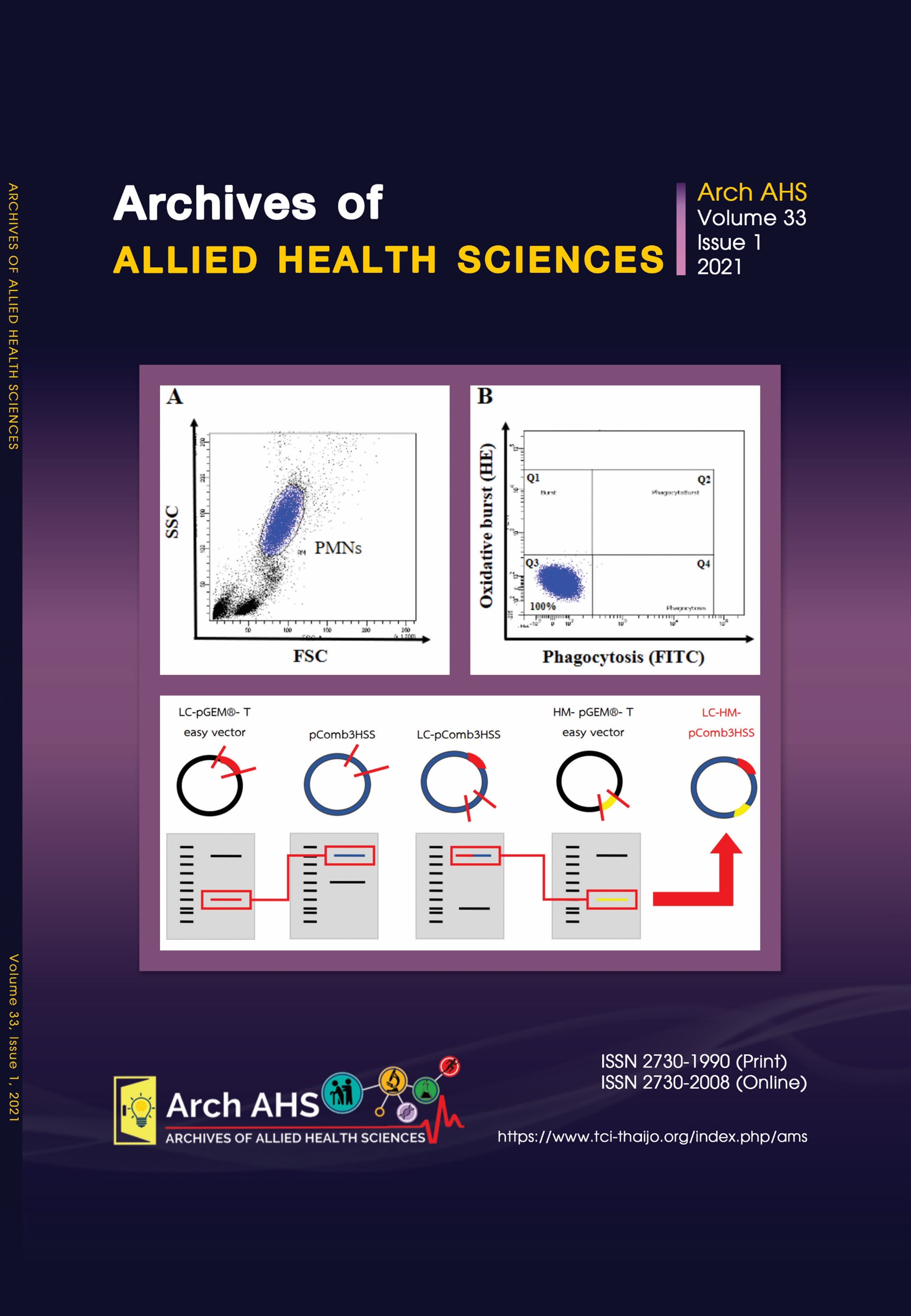Involvement of red blood cell on calcium oxalate crystal growth and aggregation in vitro
Main Article Content
Abstract
Cell membranes and their components may play an important role in stone formation. Hematuria is one of the most common manifestations in kidney disease. We therefore extensively investigate the involvement of intact red blood cell (iRBC) and red blood cell membrane fragments (fRBC) on CaOx crystal growth and aggregation. Intact RBC and fRBC were prepared from healthy blood samples. Calcium oxalate monohydrate
(COM) and calcium oxalate dihydrate (COD) crystals were investigated for crystal growth and aggregation in the condition without or with iRBC or fRBC. Crystal growth and aggregation were analyzed from crystal area
and the number of crystal aggregation, respectively, and also confrmed by using spectrophotometric oxalate depletion assay and calcium oxalate crystal aggregation-sedimentation assay, respectively. The results showed that only COM crystal with fRBC was signifcantly increased the crystal area and the number of crystal aggregation as compared to control conditions (p-value = 0.035 and p-value = 0.011, respectively) while COD crystals did not have any signifcant change to the crystal area or the number of crystal aggregates with both types of RBC. These data indicated that fRBC might promote the growth and aggregation of COM crystals. However, the molecular mechanism involvement of fRBC with COM crystals still needs to be studied.
Article Details

This work is licensed under a Creative Commons Attribution-NonCommercial-NoDerivatives 4.0 International License.
References
Boyce WH, Carolina N. Organic matrix of human urinary concretions. Am J Med 1968; 45: 673-83.
Warpehoski MA, Buscemi PJ, Osborn DC, Finlayson B, Goldberg EP. Distribution of organic matrix in calcium oxalate renal calculi. Calcif Tissue Int 1981; 33: 211-22.
Alelign T, Petros B. Kidney stone disease: an update on current concepts. Adv Urol 2018. doi: 10.1155/2018/3068365.
Ryall RL. The scientifc basis of calcium oxalate urolithiasis: predilection and precipitation, promotion and proscription. World J Urol 1993; 11: 59-65.
Khan SR, Glenton PA, Backov R, Talham DR. Presence of lipids in urine, crystals and stones: implications for the formation of kidney stones. Kidney Int 2002; 62: 2062-72.
Chutipongtanate S, Thongboonkerd V. Red blood cell membrane fragments but not intact red blood cells promote calcium oxalate monohydrate crystal growth and aggregation. J Urol 2010; 184: 743-9.
Kim KM. Mulberry particles formed by red blood cells in human weddelite stones. J Urol 1983; 129: 855-7.
Valavi E, Nickavar A, Aeene A. Urinary metabolic abnormalities in children with idiopathic hematuria. J Pediatr Urol 2019; 15: 165e1-4.
Khan SR, Kok DJ. Modulators of urinary stone formation. Front Biosci 2004; 9: 1450-2.
Nakagawa Y, Abram V, Parks JH, Lau HS, Kawooya JK, Coe FL. Urine glycoprotein crystal growth inhibitors: evidence for a molecular abnormality in calcium oxalate nephrolithiasis. J Clin Invest 1985; 76(4): 1455-62.
Chutipongtanate S, Sutthimethakorn S, Chiangjong W, Thongboonkerd V. Bacteria can promote calcium oxalate crystal growth and aggregation. J Biol Inorg Chem 2013; 18: 299-308.
Amimanan P, Tavichakorntrakool R, Fong-Ngern K, Sribenjalux P, Lulitanond A, Prasongwatana V, et al. Elongation factor Tu on Escherichia coli isolated from urine of kidney stone patients promotes calcium oxalate crystal growth and aggregation. Sci Rep 2017; 7: 2953.
Sritippayawan S, Borvornpadungkitti S, Paemanee A, Predanon C, Susaengrat W, Chuawattana D, et al. Evidence suggesting a genetic contribution to kidney stone in northeastern Thai population. Urol Res 2009; 37: 141-6.
Sayer JA. Progress in understanding the genetics of calcium-containing nephrolithiasis. J Am Soc Nephrol 2017; 28: 748-59.
Bovornpadungkitti S, Sriboonlue P, Tavichakorntrakool R, Prasongwatana V, Suwantrai S, Predanon C, et al. Potassium, sodium and magnesium contents in skeletal muscle of renal stone-formers: a study in an area of low potassium intake. J Med Assoc Thai 2000; 83(7): 756-63.
Prasongwatana V, Tavichakorntrakool R, Sriboonlue P, Wongkham C, Bovornpadungkitti S, Premgamone A, et al. Correlation between Na, K-ATPase activity and potassium and magnesium contents in skeletal muscle of renal stone patients. Southeast Asian J Trop Med Public Health 2001; 32(3): 648-53.
Khan SR. Reactive oxygen species, inflammation and calcium oxalate nephrolithiasis. Transl Androl Urol 2014; 3: 256-76.
Tavichakorntrakool R , Prasongwattana V, Sungkeeree S, Saisud P, Sribenjalux P, Pimratana C, et al. Extensive characterizations of bacteria isolated from catheterized urine and stone matrices in patients with nephrolithiasis. Nephrol Dial Transplant 2012; 27: 4125-30.
Baggio B, Gambaro G, Zambon S, Marchini F, Bassi A, Bordin L, et al. Anomalous phospholipid n-6 polyunsaturated fatty acid composition in idiopathic calcium nephrolithiasis. J Am Soc Nephrol 1996; 7: 613-20.


